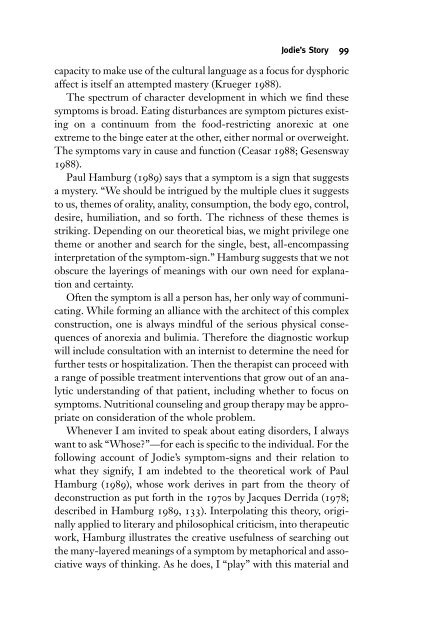Eating Disorders - fieldi
Eating Disorders - fieldi
Eating Disorders - fieldi
You also want an ePaper? Increase the reach of your titles
YUMPU automatically turns print PDFs into web optimized ePapers that Google loves.
Jodie’s Story 99<br />
capacity to make use of the cultural language as a focus for dysphoric<br />
affect is itself an attempted mastery (Krueger 1988).<br />
The spectrum of character development in which we find these<br />
symptoms is broad. <strong>Eating</strong> disturbances are symptom pictures existing<br />
on a continuum from the food-restricting anorexic at one<br />
extreme to the binge eater at the other, either normal or overweight.<br />
The symptoms vary in cause and function (Ceasar 1988; Gesensway<br />
1988).<br />
Paul Hamburg (1989) says that a symptom is a sign that suggests<br />
a mystery. “We should be intrigued by the multiple clues it suggests<br />
to us, themes of orality, anality, consumption, the body ego, control,<br />
desire, humiliation, and so forth. The richness of these themes is<br />
striking. Depending on our theoretical bias, we might privilege one<br />
theme or another and search for the single, best, all-encompassing<br />
interpretation of the symptom-sign.” Hamburg suggests that we not<br />
obscure the layerings of meanings with our own need for explanation<br />
and certainty.<br />
Often the symptom is all a person has, her only way of communicating.<br />
While forming an alliance with the architect of this complex<br />
construction, one is always mindful of the serious physical consequences<br />
of anorexia and bulimia. Therefore the diagnostic workup<br />
will include consultation with an internist to determine the need for<br />
further tests or hospitalization. Then the therapist can proceed with<br />
a range of possible treatment interventions that grow out of an analytic<br />
understanding of that patient, including whether to focus on<br />
symptoms. Nutritional counseling and group therapy may be appropriate<br />
on consideration of the whole problem.<br />
Whenever I am invited to speak about eating disorders, I always<br />
want to ask “Whose?”—for each is specific to the individual. For the<br />
following account of Jodie’s symptom-signs and their relation to<br />
what they signify, I am indebted to the theoretical work of Paul<br />
Hamburg (1989), whose work derives in part from the theory of<br />
deconstruction as put forth in the 1970s by Jacques Derrida (1978;<br />
described in Hamburg 1989, 133). Interpolating this theory, originally<br />
applied to literary and philosophical criticism, into therapeutic<br />
work, Hamburg illustrates the creative usefulness of searching out<br />
the many-layered meanings of a symptom by metaphorical and associative<br />
ways of thinking. As he does, I “play” with this material and









